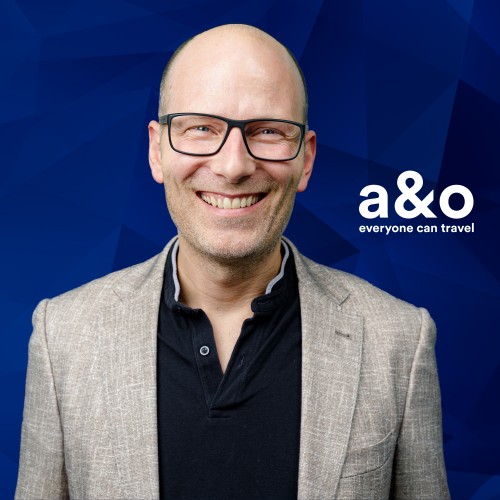Erin Francis-Cummings
Episode 89: Data-Driven Travel Marketing, with Erin Francis-Cummings
As businesses, we live or die on data. Understanding the market, understanding who is coming to our destination, who is interested but doesn’t know enough to make a decision – these pieces of information are vital to our ability to thrive in travel and tourism. But gathering and interpreting this data is a challenge for everyone.
Our guest on this episode of Destination on the Left is an expert in gathering and analyzing data, specifically for our industry. Our guest is Erin Francis-Cummings. Erin is president and CEO of Destination Analysts, where she has spent the last 15 years studying travelers from across the globe and translating their evolving, complex, and fascinating behaviors and opinions into marketing insights for Destination Analysts’ 150-plus clients.
Erin has designed research strategy and facilitated consumer research for some of the world’s greatest destination brands, including Bermuda, California, the Fiji Islands, Napa Valley, Florida, Washington DC, Chicago, and Los Angeles.
In addition to conducting research: from brand auditing to user experience, to ROI analysis, she also oversees the production of Destination Analysts, The State of the American Traveler. This is the travel industry’s longest running and most relied on tracking study of American leisure travel sentiment and behaviors. Also produced by Destination Analysts is The State of the International Traveler, an annual study of the travel behaviors and perceptions of international travelers in 13 top feeder markets to the United States. Erin currently serves on the international board of the Travel and Tourism Research Association.
Before leading Destination Analysts, Erin held advertising and marketing management roles at Amtrak and the San Francisco Travel Association. She holds a bachelor’s degree in political science from the University of California Los Angeles and is a proud mother of two school-aged children.
More on Erin’s Background
Thank you for joining me, Erin.
Thank you, Nicole.
I’m looking forward to our conversation. I know you have so much insight and so much to share, but before we dive in, I know that that bio is just a small glimpse of your background and who you really are. Could you share a little bit more about you and your story?
Absolutely. I feel like my story is one of those that should be told around this time of year when people are graduating from universities and high schools because it just proves that you never know what journey life is going to take you on.
My vision for myself after UCLA: I was going to make my way to DC and be a political speechwriter. On kind of a lark, I decided to move to San Francisco instead. I thought I’d be there just a few months. This was during the first dot-com wave. I didn’t have a job, so I signed up with one of those temporary staffing agencies, and my very first assignment was assisting the chief marketing officer for what’s now known as San Francisco Travel Association, a destination marketing organization for San Francisco. I was seated next to a man named Dave Bratton, who became my business partner for Destination Analysts.
Wow. I love how you never know where the journey will take you. I think that’s great advice for graduates thinking about where they might go in their career.
Yes. Another thing I would say, and I think people have this in their story as well, and you touch on this a lot in your podcasts; everything came crashing down after 9/11, particularly in San Francisco with also the dot-com crash. As we know, those of us know who have worked through times like this, adversity does lead to incredible creativity. I learned how to work with a very lean budget and be absolutely progressive in thinking about how to accomplish our goals, and also how to take risks.
We were very fortunate at that time at the San Francisco Travel Association that the head of marketing placed a lot of value on measurement, measuring if our marketing programs were working. Dave, who’s now my business partner in Destination Analysts did a lot of work in that area, and we worked closely together on how we set up the marketing in order to be measured appropriately. I think the idea, the genesis of our company started in that work at that time.
I love how your perspective on the effects that adverse or challenging times can have and to find that silver lining where it does lead to creativity and resourcefulness, whether it’s with the budget or risk-taking.
Then, of course, that leads to placing that value on measuring and understanding, especially when it comes to marketing, how you’re spending your money and what you’re getting in return. That’s a perfect segue into the first topic we like to cover on the show, which is creativity. Tourism and hospitality have always been competitive to a certain degree. My guess would be you’re looking at different competing forces, depending on what’s happening globally. But I’m wondering what you have done or what you’ve seen your clients do to break through all that noise and stand out from the crowd.
On our client side, not to keep harping on this, but it is that ability and also an orientation towards taking some risks. We work primarily with Destination Marketing organizations who, granted don’t always – because there’s beholden in how they’re funded – don’t always have the luxury of taking risks. Many times where we’ve seen success is when marketing leaders are in a place that understands how to take risks within that frame, and again, having a carefully constructed measurement plan in place before doing a risky marketing program always helps.

[bctt tweet=”“Many times where we’ve seen success is when marketing leaders are in a place that understands how to take risks.” – Erin Francis-Cummings #podcast”]
Pushing the Envelope
We’ve seen the most beautiful work from our clients come from those who are willing to be out there on the edge and try new things. More often than not, it does lead to success.
You’re right, depending on the organization, they might not have the luxury to take big risks, but I do like how you framed that regarding those leaders who understand the potential, push the envelope, take those risks, and then have those measurement tools in place to back themselves up. Can you give us a specific example of where you’ve seen this work? Maybe a little bit more on those measurement tools that you’ve seen be effective for this.
I would say we have been blessed to work with some progressive clients in the DMO space. One that comes to mind when you ask me that question is our client in the St. Petersburg/Clearwater area. We had approached them with this idea that no one had done before, and we knew that they would be open to it because they were the very first DMO over a decade ago now to let us try doing qualitative research and online usability testing through video conference.
So before anyone was doing qualitative research online, our friends in St. Petersburg/Clearwater allowed us to use that methodology to conduct usability research on their site. We knew they had that open-minded willingness to try new ideas. We approached them with our first idea, to integrate big data, the voice of the consumer – which we at Destination Analysts, is a key service that we provide – and also the incredible new ways that you can serve up your digital ads through networks. In this case, we used a company called Sojern based on other consumer data.
We approached them about marrying these three things together. Destination Analysts developed a web-based survey for the DMO website, which was collecting the voice of the consumer. So a visitor on the site shared about themselves through the survey. We also used Google Analytics, so the analytics or site behavior was also being captured anonymously. Then the voice of the consumer was also being served again in an anonymous way to the ad network, through the Sojern network.
This hadn’t been done before. We were able to pass very specific information about what the customer told us. We are talking to your customer, and they give a lot more insight into their mindsets and what they want from you than when you’re just trying to piece it together from the digital footprint. We asked them questions about where they were in their decision process, the types of experiences that they were interested in having at the destination. We asked them those questions, and then the information was passed to Sojern who then, working with the St. Petersburg/Clearwater DMO, had an ad creative ready to go for these audiences based on the information that they were telling us.
If they said, “I’m not sure yet about St. Pete, but the experience that I’m most interested in is the food and craft beer scene,” there was an ad that would be served up later to them to try to convert them to visitation based on that. If they were already sure, the ad that would be served up to them would try to entice them to come back to the St. Pete/Clearwater and use that site as a travel planning resource. It was a number of different advertising solutions to then match with what the customer was telling us through a survey on that end.
Are you able to track the conversion with this type of a system in place? Let’s say the customer hasn’t made their decision yet, but they like the food and beverage experiences, and then you serve them those ads that match their behavior and what their interests are, and then they click on that ad again, and they come back to the site. Is there a way to track that?
We do track it by asking people if they’d be willing for us to follow up with them. We then email them a follow-up survey after they said they were considering traveling and then ask them if they did visit and if so how much they spent so that we can attach an economic impact to that. Yes, it is full circle. Then also, even before that, because of the Google Analytics, we can see if people who came into the DMO website from the display ad if their response changes, if they said that they were now decided to visit the destination, we can look at it that way as well.
Also, what’s great about having the Google Analytics, the voice of the customer, and then advertising all together is that we can see if the advertising is indeed delivering new customers to that destination. When people tell us whether they decided to visit the destination and see if those people who are undecided are coming from the advertising, we know the advertising is doing its work and delivering new audiences to that destination.

[bctt tweet=”“What’s great about having the analytics, the voice of the customer, and then advertising all together is that we can see if the advertising is indeed delivering new customers to that destination.” – Erin Francis-Cummings #podcast”]
That’s so important for DMOs to not just improve their ROI and to prove the economic impact, but actually to prove that without them, those visitors would not have been there.
Correct. DMOs are responsible for so much. On the one side, they have to serve their existing visitors and people who are certain that they are coming. Their marketing assets absolutely have to serve that audience. We all know repeat visitation, repeat customers deliver enormous amounts of economic impact. We have to take care of and foster that relationship. At the same time, DMOs are the one organization tasked with growing tourism in their communities. They have to go out and find new markets. Not just geographic markets, but new traveler personas that they may not have thought of before but are really likely to convert to visitors. It’s a big job, and it’s a big role to do both of those things and to serve both of those objectives.
The State of the American Traveler Study
It really is. I think solutions like this one that you just described and anything that can be used to help them not only do their job better but then also track and report on what they’re doing to grow tourism is awesome.
So, Erin, I wanted to ask you about the study that Destination Analysts does, The State of the American Traveler. I’m wondering if you can share with our audience, a little bit about what that study is about because I think it’s a great resource. I’ve shared it with colleagues and clients of mine. I think it would be worthwhile for us to know a little bit more about how it works and then some insights from that study as well. Would you mind doing that with us?
No, absolutely. I can’t believe it, but we started The State of the American Traveler 12 years ago now. We started it as what we always said was a gift to the industry, especially back at that time. There wasn’t a lot of good, especially complementary information and research insights that were specific to a destination marketer. Given that our clients are primarily destination marketers, we wanted to produce something for them that they could rely on.
The State of the American Traveler moved a few years ago to quarterly production because so many of our friends in the industry began to rely on it. The purpose of State of the American Traveler is to track how the American leisure traveler is feeling about travel and to provide a crystal ball into the near future in travel. Then we use that research to illuminate the topics that are of most critical importance to destination marketers when they’re making their decisions for their marketing plans.
Each of the editions of The State of the American Traveler is themed, and we repeat these on a yearly basis. In January, destination marketers have come to expect from us the “Destinations” edition of The State of the American Traveler. We focus on the types of destinations that are hot amongst travelers and why. We highlight the type of content that travelers want to know about each of those types of destinations so that destination marketers can provide that content.
In the spring, we focus on technology. We examine travelers’ willingness to adopt new technology that’s being considered by the vendors in the travel industry being used. We want to understand how much adoption there is so marketers can be ready and also know whether they need to prioritize certain investments in certain technologies or not.
In the summer, we started out exploring the differences in travelers by generation in this country. We’ve evolved that to look at traveler personas. We go beyond a look at the generations, examining different types of traveler personas and their psychographic and behavioral differences, what their habits are, and the best ways to reach them.
Then in the fall, we’ve started to focus on mobile. As travelers have become more mobile again with our smartphones really being the device that keeps us that way, just exploring, visibility issues around mobile and what travelers are looking for vendors in the travel industry to do around making the mobile experience easier for them as they travel.
I think that’s great how you have these four editions and each one lends itself to an area of interest for destination marketers in particular. I’m wondering if there are any trends that you’re seeing or any surprises from the research you’ve done so far this year that you could share with our listeners.
You know, Nicole, the first thing that came to my mind is actually from our companion piece which is The State of the International Traveler. That piece of research had the biggest surprise for me so far this year. I’ll share with you about that, and then I will go to the American.
Well, there’s a lot of interest in international travelers, so I’m keen to hear what you have to say given the state of our political landscape right now.
For a bit of background, we have strong leadership in the U.S. travel industry right now, with everyone coming together to improve the U.S. brand internationally. The State of the International Traveler is a study that we conduct annually. We survey 800 international travelers in 14 key global feeder markets to the U.S. Again, because our clients are destination marketers, the questions we ask are geared towards what’s important to giving insights to someone trying to grow international visitation and international economic impact in their destination.
It helps the industry as a whole to take a look at perceptions and sentiment about the United States and the United States as a travel brand. This year, of course given what everyone is buzzing about and what everyone is concerned about, we asked this question to over 11,000 people: “Why are you not coming to the United States?” It was fascinating because there isn’t one across the board answer. It’s very different by market, but what we learned looking by market surprised me. I think everyone has this expectation that it’s our national politics. It certainly is. Our national politics is certainly a factor for our friends over in Europe. For international travelers in France and Germany, that was one of the top five reasons that they gave for not coming to the U.S. – disagreement with our national politics.
However, over in Asia, it was their concern for their personal safety here in the U.S. That made me really sad, because to think that this beautiful country we live in is perceived as not safe; that if they come here, their safety will be endangered. I thought of our clients who work so, so hard to provide these incredible experiences to visitors and the money invested in beautification and cleaning up streets – it is sad to know that perception is out there. It’s a big challenge for us to take on at a national level, and I’ve been very proud of the work that U.S. Travel has done in taking this sentiment seriously. They have built a coalition to make sure people have accurate perceptions of the United States. We are doing what we can do to address these types of fears.
I can see why that came top of mind when I asked you that question about what surprised you because you’re right, national politics is certainly what everyone would probably guess and personal safety, that is an inaccurate perception. I would say actually if you surveyed some of the American public about some of the international destinations they might travel to, they might say the same thing. What I think is cool though is how the U.S. travel industry is coming together to protect and improve the U.S. brand. I think that that’s so important. I feel like that takes us full circle to where we started when you talked about the silver lining in adversity or a challenge. You could say that this perception is a challenge for the U.S. How the U.S. travel industry is coming together to work on that at the national level is awesome.
You are so right, Nicole. It is completely full circle back to that. In times of challenge, that’s when people are motivated to come together and really wonderful, beautiful things happen.

[bctt tweet=”“In times of challenge, that’s when people are motivated to come together and really wonderful, beautiful things happen.” – Erin Francis-Cummings #WhyCollaborate #podcast”]
I appreciate you diving into that, and I do want to back up to The State of the American Traveler. Is there anything maybe that wasn’t surprising, but anything that you’re seeing trending that you think is important to keep on the radar of our listeners?
Sure. Our technology edition is being released shortly. I was reviewing the report yesterday and there are a few things that may be surprising to travel marketers. There was real data to support why it’s important to go after the early adopters of technology as travelers. It’s really incredible to see the differences in the early adopters versus the laggard.
These are people that travel more and spend more on travel, so potentially represent higher economic impact when you get them to their destination. They’re more social, so they’re sharing more, as you might expect. Marketers know the long-term impact of someone who is maybe not an “influencer” in a larger sense, but influential as they share things about their travel.
Also, they’re more diverse, particularly ethnically. I think that’s great for destinations, especially who have been seen as maybe not diverse. But if they market to this group of early adopters and travel and get them to start coming to their destinations, it can have this long-term impact, changing the perception on a brand level that they are for a more diverse audience.

[bctt tweet=”“If they market to early adopters of technology to come to their destinations, it can have this long-term impact, changing the perception on a brand level that they are for a more diverse audience.” – Erin Francis-Cummings #podcast”]
Marketing to Early Adopters of Technology with VR
When you think about the data that supports going after these early adopters, do any marketing tactics come to mind as to how a destination might take this data and then say, “Yes, we are going to appeal to those people who are early adopters with technology?”
Have you seen anything creatively regarding destinations taking advantage of that market, or being able to reach that market?
Yes, in a couple of ways. I think with VR and real-time video; these aren’t super new technologies, but they’re still fairly new to travel. They’re not ubiquitous in travel, but destination marketers who have been able to provide content in those areas solve certain questions early adopters may have because it is available to them through technology that they want to use. With VR, we did a lot of qualitative research; interviewing travelers about how they would want to use VR content in travel. What we found was an openness to VR and the desire to use VR to help solve an uncertainty, particularly with younger travelers, so those in their late 20s, early 30s who are challenged for vacation time and more challenged for finances.
It’s a big risk to decide on a destination. They want to make sure that they are making the right choice because again, it’s a significant investment of their time and money. VR content, because it’s so immersive and gives someone such a complete picture of what it’s like to be in a destination, actually helps them overcome that uncertainty. It provides a little bit of certainty to that so that they feel good about the choice that they’re making. It’s just another basic piece of data that they have to feel good about a choice that they’re making, selecting a destination.

[bctt tweet=”“It’s a big risk to decide on a destination. VR content, because it’s so immersive and gives someone such a complete picture of what it’s like to be in a destination, actually helps them overcome that uncertainty.” – Erin Francis-Cummings #podcast”]
That’s a great example. I know VR is not new, but I do agree with you that there are still so many destination marketers out there trying to figure out how to best utilize it. When you get down to this whole idea of solving uncertainty, that should help destination marketers formulate their strategy with VR and provide the content that answers the question.
Yes. With these new technologies unfortunately for destination marketers, it’s really chicken or egg. There has to be the right content out there to shift consumer behavior, but on their sometimes waiting for the consumer to demonstrate the need for it before the destination marketer invests in it. One group has to move forward before the other does.
Right, absolutely. That ties back to the whole idea of taking some risks, but more educated risks because you have this data to kind of back up that this is where things might be going.
Yes. I think if you’re a destination that’s doing your work and really understands who visits – and I feel confident all our clients that we do the visitor profile for are in this position – you understand who is visiting you now. If you have a high proportion of your current visitors who fit into that new technology adopter, then it’s not as much of a risk for you, because you know these are people that are already coming to you. It’s not as much of a risk to go at them and create this type of content in this new space for them. It’s more of a risk for a destination in which they don’t have a lot of that type of audience right now.
Right. I think that’s a good point. So even though we might have this piece of information about early adopters as being a good audience to target, the destination needs to understand who’s currently coming, so they attract the right demographic with the right marketing asset. Am I tracking with you?
Yes.
Successful Coopetition Partnership
Well, Erin, I knew you would have so much to share with us, and we have so much to learn. Before we say goodbye though, I want to make sure that we do cover collaboration, which is the other topic that we like to discuss on this show. I’m wondering about all of the different projects that you’ve been involved in and the different destinations that you work with, are there any examples of collaboration? When I talk about collaboration, I’m also thinking I like to call “coopetition” where essentially perceived competitors end up collaborating because they can create something much better by joining forces than they can on their own. Is there anything that comes to mind, an example of where you’ve seen that work for any of your clients or any destinations you’re familiar with?
Yes. Before I get into the client side, I will say that over here on the vendor side, coop-etition absolutely also is a win, win for the industry and for our clients. All data and research providers in the travel and tourism industry are to some degree competing for that same research budget, so there’s a competition there for that and who gets a proportion of the budget. But putting that aside, when companies that provide different services and different benefits on the research and data side can work together, there’s just so much more depth and actionability on the insights that come out of it. When we work with the big data partners serving our industry, the Arrivalists, the ADARAs, marrying it with what we’re learning from the voice of the consumer doing our survey research, it’s a more complete, actionable picture for our clients to work off of.
Great point. I’ve had guests on this podcast who have talked a lot about the different research that they used to inform their decision making, and it’s not generally just a stand-alone piece of research, it’s all of that. Being aligned and working with those other research partners provides a more complete picture.
Yes. On the client side, I’ve seen cooperation lead to better marketing amongst destinations that should be competitors. When they look at the data and realize that travelers are not just going to one destination and skipping the other; they’re going to both or have an aspiration to go to both. So look at the aspiration and the actual travel trends. “Okay, I’m Los Angeles, but I actually should partner with New York in this new emerging market for the United States. Because this traveler, if they’re going to come to the United States, the top two places that they want to go are our two destinations. Even though we are rivals, it’s best for us to market together to get that win for the United States and then us individually rather than them thinking that they can’t have both and then just skipping coming to the U.S. altogether.”
I think that’s a perfect example, especially if you’re talking about an emerging market, but I can see where that would work in more than just the emerging markets. Even if they don’t hit them both on their first visit, they’ll do one, and when they come back, they’ll do the other.
You know, Nicole, I’ve really been fortunate. In the destination marketing industry, there is so much collaboration, even among very competitive destinations. I feel grateful all the time that I work in an industry that is full of very kind people that see the greater good of our overall travel industry and are so willing to collaborate and partner.
I totally agree, which is why I like to explore this topic on this show. I see it all the time. I think it’s unique to our industry. I know collaboration happens in other industries, but to your point, just how open and nice everyone is and willing to work together is unique.
I believe so also. We’re based here in San Francisco, and I’ll just say I’ve never seen my friends that work at Facebook go out of their way to collaborate with friends that work at Google.
That’s great. Well, Erin, this has been a great conversation. I wanted to let our listeners know where they can go find these great studies that you put out. Where can we go to find these great resources?
Our website is destinationanalysts.com and if you tap on traveler studies from the main navigation, you can see summary reports of The State of the American Traveler over, again, the last 12 years, as well as shorter summaries of the insights from The State of the International Traveler.
Thank you so much for taking time out of your schedule to talk to us today. We’ll look forward to catching up with you again.
Thank you so much, Nicole. Take care.
Resources:
- Web Site: destinationanalysts.com
- The State of the American Traveler Study: http://www.destinationanalysts.com/the-state-of-the-international-traveler-study/the-state-of-the-american-traveler-study/
- The State of the International Traveler Study: http://www.destinationanalysts.com/the-state-of-the-international-traveler-study/
We value your thoughts and feedback and would love to hear from you. Leave us a review on your favorite streaming platform to let us know what you want to hear more of. Here is a quick tutorial on how to leave us a rating and review on iTunes!







